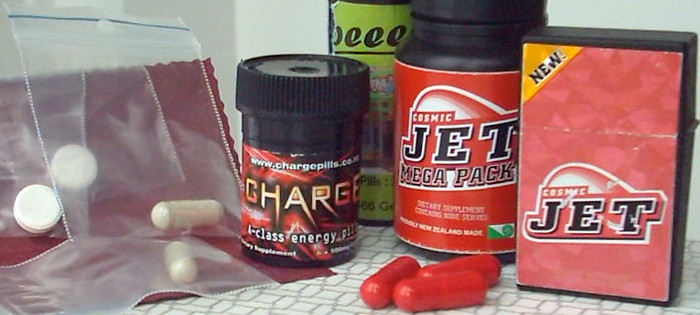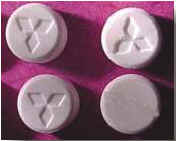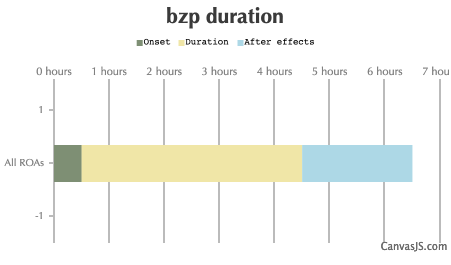[ Home ] [ Controlled Substances ] [ Stimulants ]
BENZYLPIPERAZINE
|

Some Products Containing BZP
BZP is a common name for the synthetic drug N-benzylpiperazine, a stimulant that produces euphoria and cardiovascular effects and is approximately 10 to 20 times less potent than amphetamine in producing these effects. BZP tablets, especially those that also contain the hallucinogen TFMPP (1-(3-trifluoromethylphenyl)piperazine), often are sold as MDMA (3,4-methylenedioxymethamphetamine, also known as ecstasy) or promoted as an alternative to MDMA.


https://www.justice.gov/archive/ndic/pubs11/11052/11052p.pdf
BZP has been identified as a component drug in many seized ecstasy tablets, and has similar subjective effects to MDMA. In fact, its rise in popularity is due at least in part to the decline in the availability of MDMA. However, they are different drugs, and much less is known about how BZP affects the body and brain than is known about ecstasy.
BZP is often used in so-called party pills, often in combination with other emergent drugs. A typical dose of BZP is 75 to 150mg, which can take two hours to take effect, and results in a trip of six to eight hours. It is often mixed with two or three other drugs - combinations that can create a complicated array of effects and symptoms.
In low doses, the effects of BZP are stimulating, similar to amphetamines. Higher doses can result in hallucinogenic effects, including delusions and hallucinations.
These compounds can cause harmful effects when taken recreationally.

https://www.verywellmind.com/benzylpiperazine-bzp-definition-21892
BZP peaked in 2009:
BZP is often abused in combination with TFMPP (a non controlled substance). This combination has been promoted as a substitute for MDMA.
N- Benzylpiperazine (BZP) was first synthesized in 1944 as a potential antiparasitic agent. It was subsequently shown to possess antidepressant activity and amphetamine-like effects, but was not developed for marketing. The amphetamine-like effects of BZP attracted the attention of drug abusers. Since 1996, BZP has been abused by drug abusers. Illicit distributions occur through smuggling of bulk powder through drug trafficking organizations with connections to overseas sources of supply. The bulk powder is then processed into capsules and tablets. BZP is encountered as pink, white, off-white, purple, orange, tan, and mottle orange-brown tablets. These tablets bear imprints commonly seen on MDMA tablets such as housefly, crown, heart, butterfly, smiley face or bull's head logos and are often sold as "ecstasy." BZP has been found in powder or liquid form which is packaged in small convenience sizes.
BZP is illegal:

BZP is a common name for the synthetic drug N-benzylpiperazine, a stimulant that produces euphoria and cardiovascular effects and is approximately 10 to 20 times less potent than amphetamine in producing these effects. BZP tablets, often are sold as MDMA (also known as ecstasy) or promoted as an alternative to MDMA. BZP typically is available as a powder, which may be packaged in small glass or plastic vials or in small plastic resealable bags. BZP powder often is pressed into tablets, many of which are embossed with logos. BZP is occasionally available in capsules.
BZP usually is consumed orally. The drug also can be snorted or smoked, but these methods of administration are less common. Common oral dosages of BZP range from 20 to 200 milligrams. The effects of BZP generally last from 6 to 8 hours.

https://www.justice.gov/archive/ndic/pubs11/11052/index.htm
BZP (Benzylpiperazine) is a synthetic stimulant derived from piperazine It is often seen as an alternative to ecstasy or amphetamine, although usually considered to be less potent than these drugs. BZP is sold as a tablet, capsule or an off-white powder. BZP pills are marketed under a huge variety of names and the tablets come in many different shapes. Sometimes the BZP chemical can be found in ecstasy tablets.
The use of BZP has similar effects to other synthetic stimulants such as ecstasy or amphetamines. Users experience a sense of euphoria and increased alertness, enhanced senses and a raised heart rate, coupled with a decrease in appetite.

https://www.drugwise.org.uk/bzp/
New Zealand 2010:
Benzylpiperazine BZP is a drug that produces amphetamine-like effects in humans, including an elevated sense of energy and euphoria. Since the mid-1990s the chemical has been reported to have been used as a recreational stimulant.
New Zealand has led the world in the legal sale and uncontrolled use of the recreational drug benzylpiperazine (BZP), the active ingredient of 'party pills'. One survey found that 40% of 18 - 29-year-olds admitted to using BZP based party pills while, in another study, 44% of first-year university students had used the drug. During the period it was legally available for sale, BZP usage in New Zealand far exceeded the usage of any illicit drugs other than cannabis. In 2008, the sale and possession of BZP was criminalized, with the result that (a) some users possibly switched to other illegal drugs, and (b) a market developed for alternative party pills that are BZP-free but contain unregulated substances that may themselves pose a health risk.

https://www.tandfonline.com/doi/full/10.1080/03036758.2011.557036
| Duration: A stimulant that was sold as "legal ecstasy" in the late 2000s, and was one of the first drugs widely marketed as a "research chemical." It has a much less favourable effect profile and has fallen out of popularity greatly since it was banned in many countries. | |||
| Route | Onset | Duration | After Effects |
|---|---|---|---|
| Tripsit Factsheets | |||

BZP Basic Information: http://drugs.tripsit.me/bzp | |||
| All ROAs: | 30-45 minutes | 4-6 hours | 2-4 hours |

| |||
World Health Organization 2012:
- BZP is a piperazine derivative with stimulant properties (including euphoria).
- BZP has never been licensed as a medicine but was found to be an active metabolite of a proposed anti-depressant (piberaline), later discontinued.
- Abuse was first reported in the late 1990s in the USA and Scandinavia but has since been reported in many other countries (particularly New Zealand, Australia and in Europe).
- The mode of abuse is similar to that of "Ecstasy" with many users seeking MDMA-like effects.
- Many suppliers of BZP market the substanceas "legal Ecstasy" or as a "legal high". Such products typically contain other piperazine derivatives in variable quantities.
- Toxic effects have been reported in users (agitation, tachycardia and seizures) with associated hospital admissions, but cases involving BZP alone are rare.
- Although BZP has been found in fatalities, due to the manner of death and/or the presence of other substances, it is difficult to specifically determine the toxicological significance of BZP in these instances.
- Animal studies have indicated both an abuse and dependence potential for BZP but human clinical studies to support this are limited.

 World Health Organization BZP Pre-Review Report (PDF 31 pages):
World Health Organization BZP Pre-Review Report (PDF 31 pages):
https://www.who.int/medicines/areas/quality_safety/5.3aBZP_Pre-review.pdf
EMCDDA - Europol Joint Report 2007:
- 1-benzylpiperazine was first notified via the EWS in 1999, but its emergence as a recreational drug with potential for rapid spread in Europe lay relatively latent until the second half of 2004. In the last two years, BZP-containing products are aggressively marketed by various retailers as a legal alternative to ecstasy, but clearly specified as piperazine products, often erroneously or intentionally misrepresented as 'natural' or 'herbal'. On the illegal drugs market, BZP may also be sold/bought as the popular drug ecstasy.
- Twelve Member States and one Third State (Norway) reported to Europol and/or EMCDDA seizures of BZP in powder, capsule or tablets, ranging from 1 capsule/tablet up to 64,900 tablets.
- The total amount of seized BZP in the Member States is small when compared to overall ecstasy seizures in the European Union (over 15 million tablets annually in recent years).
- The marked psychoactive effects of BZP - stimulant or ecstasy-like when combined with TFMPP - may appeal to users and help create specific demand or market for BZP-containing products. This may be also due to BZP's legal status, accessibility and perceived safety. All these factors may contribute to the establishment of BZP as a recreational drug of choice in its own right.
- There is some evidence about health risks related to BZP use, in particular, its short-term toxicity.
- Five Member States control 1-benzylpiperazine under drug control or equivalent legislation and two Member States regulate 1-benzylpiperazine under their medicines-related legislation.
- BZP has no known medical use (human or veterinary) in the European Union.

 BZP Joint Reports 2010 (PDF 27 pages):
BZP Joint Reports 2010 (PDF 27 pages):
https://www.emcdda.europa.eu/system/files/publications/415/2007_BZP_Joint_report_279846.pdf

 European Monitoring Centre for Drugs and Drug Addiction BZP (PDF 96 pages):
European Monitoring Centre for Drugs and Drug Addiction BZP (PDF 96 pages):
http://www.emcdda.europa.eu/attachements.cfm/att_70975_EN_EMCDDA_risk_assessment_8.pdf

https://erowid.org/experiences/subs/exp_BZP.shtml


https://www.drugsandalcohol.ie/13909/1/Home_Office_ACMD-BZP-Report.pdf
The effects produced by BZP are comparable to those produced by amphetamine
- A recreational drug
- Has euphoriant and stimulant properties
- It is often claimed that BZP was originally synthesized as a potential antihelminthic (anti-parasitic) agent for use in farm animals. It was discovered that BZP had side effects and was largely abandoned as a worm treatment.
- It next appears in the literature in the 1970s when it was investigated as a potential antidepressant medication, but rejected when research reported that BZP had amphetamine-like effects and was liable to abuse.
- In the early 1990s, the United States DEA noted the drug was being used recreationally in California.
- In the early 1990s BZP was being used as an adulterant in illicit drugs.
- Not long after, there was an explosion in the drug's use worldwide.
- In the United States, it is still used as an adulterant in ecstasy mimic tablets.
- BZP comes as either the hydrochloride salt or a free base. The hydrochloride salt is a white solid while the base form is a slightly yellowish-green liquid
No deaths have been reported following a sole ingestion of BZP, although there have been at least two deaths from the combination of BZP and MDMA
Adverse effects have been reported following its use including acute psychosis, renal toxicity and seizures
 Some Products Containing BZP Image from:
Some Products Containing BZP Image from:
https://en.wikipedia.org/wiki/File:Bzp_brands.jpg
Side Effect of the Recreational Drug N-benzylpiperazine - The recreational drug N-benzylpiperazine can cause kidney damage. Another drug that is used as a party pill is N-benzylpiperazine. It is available in pills like A2, Nemesis, Frenzy, Charge Herbal, ... Thursday February 23, 2012 - medindia.net Keyword: Benzylpiperazine - The nightmare is over for jockey Olivier Doleuze, who emerged from a May 21 inquiry by Hong Kong Jockey Club stewards into a drug "irregularity" without a case to answer. The Association of Racing ... Three New Drugs Never Before Seen In Australia Are Being Sold To Unsuspecting Canberrans - Chemists at a pill testing site in Canberra have discovered three recreational drugs never before seen in Australia. Users brought what they believed to be Ritalin, ketamine and amphetamine to be ... Canberra chemists identify three new recreational drugs after mystery substances turn up at Australia's only fixed pill-testing site - Three mysterious recreational drugs have surfaced for the first time in Australia with chemists describing them as "unexpected, new psychoactive substances". Chemists expose three previously unknown ... Throckley businessman jailed over drugs ring - DRUGS worth £1m on the street were seized by police in an operation Cocaine, cannabis, amphetamine and benzylpiperazine pills were recovered as eight men were jailed for a sophisticated criminal ... Nephrotoxic effects of designer drugs: synthetic is not better! - Designer drugs are synthetic, psychoactive substances with similar structures and activity to existing scheduled drugs or controlled chemical compounds. The use of these drugs is not generally ...
| ||
| Stimulants | Link to this page |




